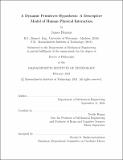A Dynamic Primitives Hypothesis: a Descriptive Model of Human Physical Interaction
Author(s)
Hermus, James
DownloadThesis PDF (29.70Mb)
Advisor
Hogan, Neville
Terms of use
Metadata
Show full item recordAbstract
Physical interaction is a key aspect of activities of daily living. These tasks require simultaneous regulation of both force and motion. For example, even a task as simple as opening a door presents a challenge to the development of prosthetics, exoskeletons, and human-robot interaction. Motor neuroscience has reported systematic patterns of motion during free reaching and force during static posture. However, similar results do not extend to physical interaction. A descriptive model is required.
The paradox of human performance: Despite large feedback delays, and many degrees of freedom, humans are incredibly dexterous and excel at physical interaction with complex objects. To accomplish such performance, we hypothesize that motor behavior, with and without physical interaction, is constructed using a limited set of primitive dynamic behaviors, including oscillations, submovements, and mechanical impedance. We not only propose that these `building blocks' exist but that their connectivity is important -- a Norton equivalent network.
This thesis is composed of four components that systematically investigated this hypothesis. (1) Through the study of crank turning we presented evidence for dynamic primitives. (2) To test the hypothesis, a method to estimate impedance during crank turning was developed. (3) When kinematic redundancy was substantial, a dynamic primitive-based control resolved redundancy without compromising performance. (4) This hypothesis led to the development of an experiment which falsified a common assumption, that humans can directly regulate force during motion.
While it is fundamentally hard to prove hypotheses in human motor control, the hypothesis of dynamic primitives can descriptively account for systematic patterns in constrained motion. Furthermore, the value of this hypothesis was demonstrated in robotics by simplifying the management of kinematic redundancy and force regulation.
Date issued
2023-02Department
Massachusetts Institute of Technology. Department of Mechanical EngineeringPublisher
Massachusetts Institute of Technology